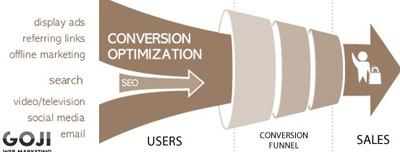If you manage a brand with an online presence (eg. a website, social media, or email marketing program) then increasing conversions such as sales leads, requests for quotes, or general enquiries will no doubt be a major focus. ‘Conversion optimisation’, aka conversion rate optimisation (CRO) is a the science of converting your web traffic into profitable sales leads.
It involves the analysis of the various marketing channels to your website such as, email, content marketing, paid search, display advertising or social media to identify firstly – which channels and secondarily, which web pages are your best and worst performing. In the case of ecommerce websites, conversion optimisation is particularly concerned with counteracting “shopping cart abandonment” – used to describe the rate at which customers leave a website without taking the desired action, such as making a booking or online sale, part way through the ordering process.
One of the biggest fears of businesses is that conversion rates may decline regardless of any changes they undertake on their websites. However, with a data-oriented approach, or by hiring an analytics or conversion specialist, one should make gradual and long lasting progress to greater returns. For those with less resources at their disposal, we wanted to provide some quick tips to get you there faster.
Quick Tips to Improve your Conversion Rates
- Use call-to-action button effectively
A call-to-action (CTA) could be a phone number to call, a button to provide more info, or a web chat session. A CRO professional who has handled conversion optimisation tasks of different magnitude understands the importance of call-to-actions (CTAs). Even though there have been varied opinions on the most effective colour for CTA buttons, what matters is the use of a colour that corresponds well with the background of your website. In other words, there should be better contrast between the background colour and the CTA button so that visitors can see the latter clearly and act upon whatever it is you want them to do. In general, CTA’s should be numerous enough to notice frequently, obvious and enticing.
- Avoid stock photos
In a bid to boost conversion rate optimisation, many people stock their websites with loads of stock photos as well as models to spice up the site and make it look “more professional.” This strategy can backfire as it makes your website – and by extension, your business – lose credibility in the eyes of potential customers. Instead, stay true by using photos of real people, such as, employees or management as most internet users prefer to deal with real people to who they can forward their concerns or queries about certain products or services. Use of real photos can increase signups as they solidify relations between target customers and your business, influencing the former’s willingness to pick up the phone and make the initial sales call.
- Use clear headlines
Headlines are of utmost importance to your CRO efforts as they are one of the most noticeable elements on your website’s landing page. Increasing conversions can sometimes be as simple as the addition of a single word to your headline.
- Display of contact details
Enhance your credibility by displaying your company contact details clearly. Ideally include a Google Map iframe of your location on your contact page.
Include multiple contact methods, such as email, phone, web form (tested in multiple browsers and devices) and even a web chat facility if you have this available. Apart from cementing your business’s credibility, it shows potential customers that they can easily approach or access you in case they need assistance with their concerns or problems regarding your products or services.
- Proper use of testimonials
In a world where anything is possible, many businesses or individuals use fake testimonials to try to prove their credibility. A proper and genuine testimonial is one which includes real photos of previous customers as well as their full names. Such testimonials do the marketing for you by emphasizing the uniqueness of your products or services in addition to outlining its benefits.
- Use of trust badges
Don’t hesitate to take advantage of positive reviews that you receive on other websites. You can liaise with these websites so that they can add a widget to your site. Possible sites you can liaise with in this regard include Product Review, Yelp, Trust Pilot or Glassdoor, among others. This strategy can boost your conversion optimisation efforts due to the efficiency of the aforementioned websites as word of mouth advertising on the Internet.
- Make it urgent
When providing incentives for your site visitors, put a time limit on these offers to give them a reason to act on the call-to-action now – rather than later. For example, you could offer to provide shipping to people who order for your products within a certain period – say, one week after the inception of the offer. Visitors in need of your products are likely to click on the CTA button in a bid to beat the deadline.
- Use videos for CRO
A qualified CRO specialist will always think about the possibility of using videos on your website to pump up conversion rates. The videos should show your products or services; you could also produce instructional videos in case your service offerings are longer and more complicated than a simple solution. Make your videos at least 2 or 3 minutes in length – opting for a longer one has the potential to bore your visitors who, just like other Internet users – consume information by skimming.
- Edit CTA text for better conversion rates
The way your call-to-action text is framed will determine the improvement or deterioration of your website’s conversion rates. A CRO specialist with in-depth knowledge of the impact of CTA on conversion rates will tell you that it needs to provide a hint to visitors regarding the next step after acting upon the CTA. For example, in addition to using CTA-oriented words, such as, sign-up or submit, you could add words, such as, ‘get started’.
- Reduce automatic image sliders
One of the greatest misconceptions regarding conversion optimisation is that the use of automatic image sliders is a great communicator. However many now understand that this often unnecessary element that can hamper the visitors’ browsing experience by preventing them from exploring the website at their own pace. It can also ferment ‘banner blindness’ whereby visitors ignore crucial information presented on banners. This can translate into low conversion rates, especially when the CTA is contained within these banners. The key to avoid this is to use image sliders that have pause and play buttons hence allowing visitors to control the pace at which they sample the information. If absolutely necessary, try to reduce the number of slides to a minimum.
Split testing as a form of conversion optimisation
Split testing involves testing different versions of a webpage or element (such as a button or layout) to ascertain which one among them is most effective at converting visitors to partake in a desired action. Apart from webpages, split testing can also be used at determining the effectiveness of banner ads, brochures or text ads. The main areas of interest for CRO experts when conducting split testing are signups, account registrations, purchases, or the acquisition of new followers on social media.
There are many hypotheses you can apply to split testing to gather important information about visitors to your website. Neil Patel believes many website owners have run out of meaningful tests to carry out hence they have been unable to see any gains from their websites.
Using Google Analytics for split testing
Thanks to Google Analytics Content Experiments, you can conduct split testing to determine how well your webpages are working in influencing your visitors to take a certain action – e.g. purchasing products or signing up for email newsletters. According to Google, this tool allows CRO experts to compare the performance of different pages using random samples of visitors to the affected websites. It also enables you to select which element of your webpage to test as well as control the number of traffic you want to incorporate in your experiment.
The first step is to create a Google Analytics account using your Google account after which you can add the former’s snippet, which is Javascript-based. Then, you need to select a goal for the split test, which will put you on the path to beginning the experiment by accessing the ‘experiment’ section. The creation of the experiment begins with the confirmation of the control page before adding URLs for each of the webpage variations. To check whether your split testing is working, you can go to the control page in your browser where you will be automatically redirected to one of your webpage variations.
Using Optimizely for split testing
Optimizely is another tool that you could use for spilt testing your webpage(s). It requires no coding or engineering to make it effective except when providing your vendor or CRO expert with a snippet of a code that will enable you edit your site through Optimizely. As is the case with Google Analytics, you first need to create an account with Optimizely; you also need to be clear on what you want to optimise and outline your experiment. While running your tests, you can use this tool’s editor to tweak the textual and design elements on your site. As more traffic trickles to your website, you will get more data, which enhances the performance of your split tests. The figures will be able to tell you whether your changes to the website are bearing fruits or not.
Conversion optimisation is a great chance for businesses, individuals or charity organisations to boost their sales by converting visitors on their websites into customers. This is only possible if they understand the ingredients needed for their websites that can encourage or compel visitors into acting upon a CTA. The presence of many tools for conducting split tests means that website owners are spoilt for choices when it comes to CRO.
Get your free Sydney, NSW conversion rate optimisation assessment today by contacting Matt at Goji Web using the details below.
MORE DIGITAL MARKETING SERVICES
SEO Consulting – Sydney and Australia
Google Analytics Support – Sydney and NSW



This is a full of information article especially to business men like me and for boosting our sales. I recommend this one. I will read your articles. A good information, Never wasted.